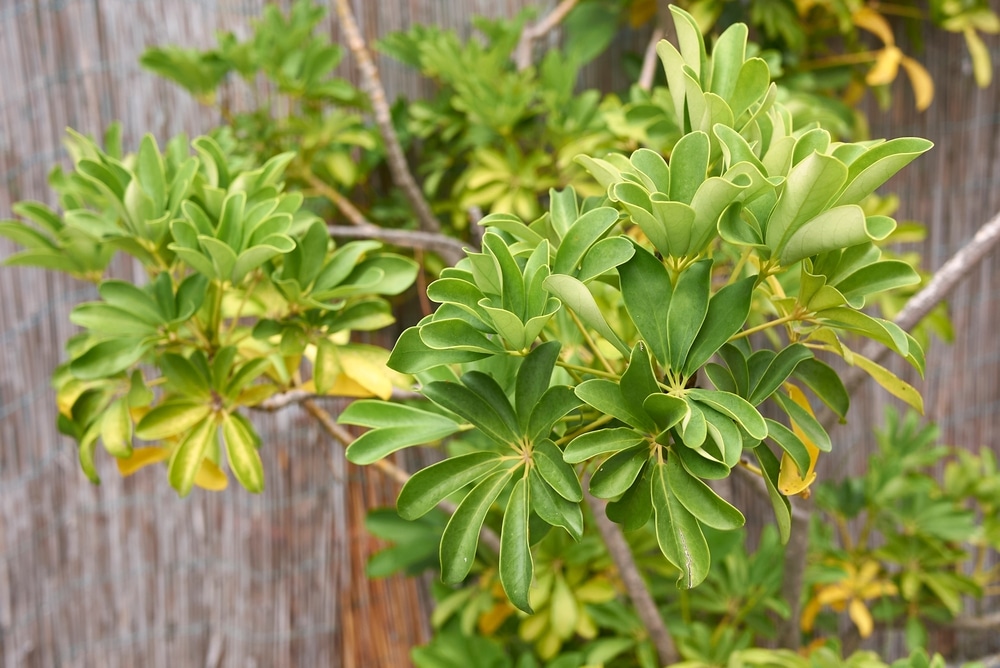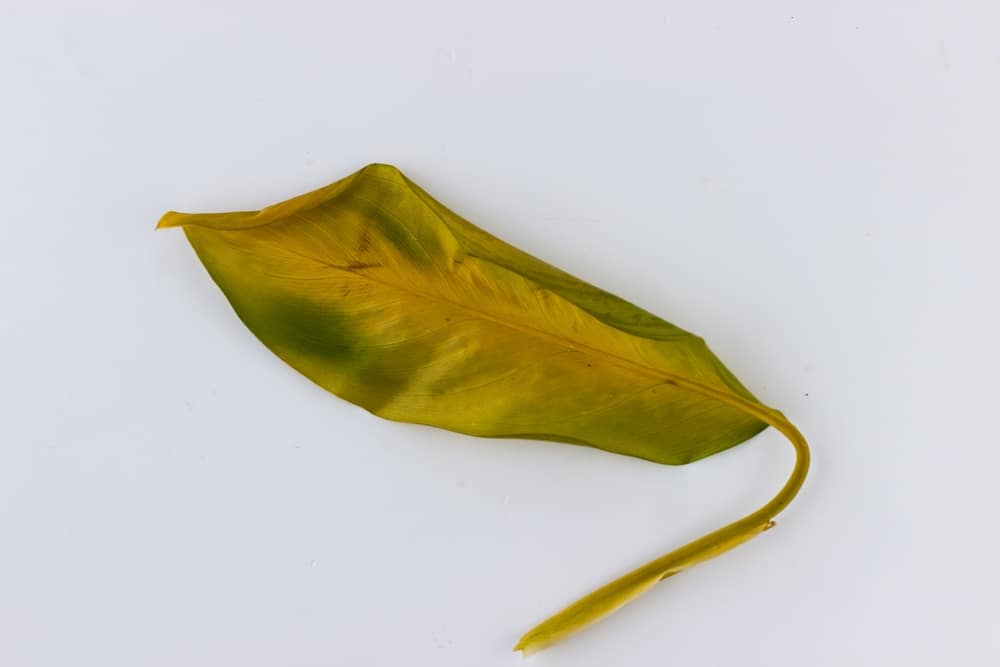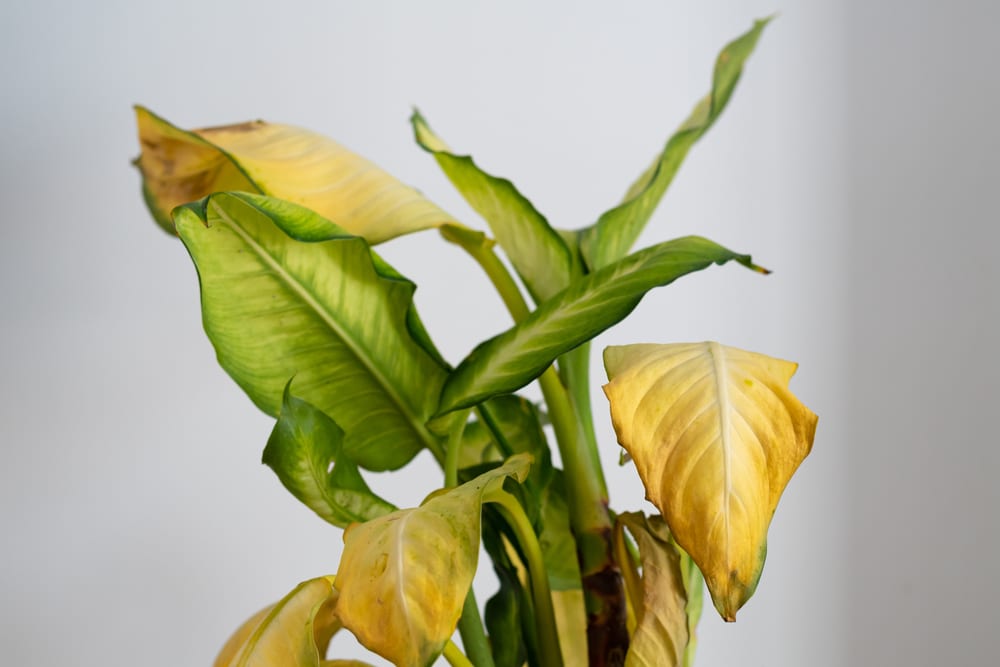One of the greatest fears that a gardener can have is helplessly watching their plants’ leaves turn yellow. While there are many reasons that this could be happening, the good news is that it is often easy to fix.
Keep reading to learn about some of the most common reasons for new growth leaves turning yellow as well as what you can do to correct the issue.
Reasons for New Growth Leaves Turning Yellow
If your plants are recently producing new growth that is then turning yellow, it’s likely due to one of the following reasons.
1. Underwatering
One of the most common reasons for new growth leaves turning yellow is underwatering. This is especially true if the leaves are wilting or drooping in addition to turning yellow.
When plants don’t receive enough water, their leaves will begin to turn yellow as a way of indicating that they are stressed.
Solution:
If you think that your plant might be suffering from underwatering, the first thing that you should do is check the moisture level of the soil.
If it is dry to the touch, water your plant deeply and then continue to water it on a regular basis until the leaves return to their normal color.
2. Overwatering
It’s important to note that overwatering can also cause new growth leaves to turn yellow. One clear sign of a plant that is being overwatered is leaves that look dull in the beginning, and then turn yellow after a few weeks.
Solution:
If you’re unsure whether your plant is being overwatered or underwater, err on the side of too little water rather than too much. That’s in consideration that too much water can quickly lead to root rot, which will kill your plant.
3. Nutrient deficiencies
Plants need a variety of nutrients in order to stay healthy. If your plant is lacking in any of these essential nutrients, it will begin to show signs of stress, including new growth leaves that turn yellow.
The most common nutrient deficiencies that can cause new leaves to turn yellow are nitrogen, potassium, zinc, sulfur, iron, and magnesium.
Solution:
If you think that your plant might have a nutrient deficiency, the best thing to do is to have the soil tested. This will give you a good idea of which nutrients are lacking and how to best address the issue.
Below’s a quick summary of how to treat nutrient deficiency.
- Nitrogen: Add used coffee grounds or manure-based compost to the soil.
- Magnesium: Adding Epsom salts or a fertilizer that contains magnesium sulfate can help.
- Sulfur: Add elemental sulfur to the soil or use a fertilizer that contains ammonium sulfate.
- Zinc: Zinc deficiencies can be treated by adding a fertilizer that contains this nutrient or spraying with kelp extract
- Iron: Fix iron deficiencies by lowering the soil pH to below 7, and adding chelated iron supplements.
- Potassium: Add veggie and/or fruit-rich compost. Burying citrus roots into the soil around the base of the plant also helps. You can also use a potassium-specific fertilizer to correct the deficiency.
4. Over-fertilization
Just as plants need nutrients to stay healthy, too much of a good thing can also be harmful. Over-fertilization is one of the most common reasons for new growth leaves turning yellow.
When a plant is over-fertilized, the roots are unable to take up all of the nutrients that are available. Sometimes, adding too much fertilizer can actually change the soil’s pH, making it more alkaline or acidic. This can also lead to nutrient deficiencies depending on the extent of the change.
Solution:
If you think that your plant has been over-fertilized, the first thing you should do is flush the soil with water. This will help to remove some of the excess fertilizer.
You should then back off on the fertilizer, and only fertilize your plant when it is absolutely necessary. When you do fertilize, make sure to only use the amount that is recommended on the package.
5. Pest infestation
Pests can also cause new growth leaves to turn yellow. The most common pests that attack plants are aphids, mites, and whiteflies. These pests suck the sap out of the plant, which can cause the leaves to turn yellow. In severe cases, an infestation can even kill the plant.
Solution:
In the case of a pest infestation, blasting the plant with water from a hose can help to remove some of the pests. You can also use insecticidal soap or neem oil to kill the pests.
If the infestation is severe, you may need to use a chemical pesticide. Be sure to follow the directions on the package carefully to avoid harming your plant.
6. Sunlight issues
Too much or too little sunlight can also cause new growth leaves to turn yellow. If your plant is getting too much sun, the leaves will begin to scorch and turn brown or yellow. On the other hand, if your plant isn’t getting enough sun, the leaves will turn pale and yellow.
Solution:
The best way to solve this problem is to simply move your plant to a location that has the right amount of sunlight. If your plant is getting too much sun, try placing it in a shadier spot. If it’s not getting enough sun, move it to a sunnier location.
You can also adjust the amount of light your plant is getting by using a sheer curtain or blind to filter the light. For outdoor plants, shade cloths can also be used to provide protection from the sun.
7. Environmental conditions
There are a number of environmental conditions that can cause new growth leaves to turn yellow. Extreme temperatures, either too hot or too cold, can stress the plant and cause the leaves to turn yellow. Drought conditions can also cause this problem, as the plant won’t have enough water to stay healthy.
Solution:
To solve this problem, you will need to adjust the conditions that your plant is growing in. If it’s too hot or too cold, try moving it to a location with more moderate temperatures. If it’s not getting enough water, make sure to water it regularly.
You can also protect your plant from extreme weather conditions by using a greenhouse.
8. Fungus infection
Fungal infections are another common cause of new growth leaves turning yellow. These infections can be caused by a number of different fungi. The one that is frequently responsible for yellowing in new plants is the downy mildew.
Solution:
The best way to solve this problem is to prevent it from happening in the first place. Make sure to plant your new plants in well-draining soil. If you see any signs of a fungus infection, such as yellowing leaves, treat the plant with a fungicide.
You can also help to prevent fungus infections by keeping the leaves of your plant dry. Water early in the day so that the leaves have time to dry before nightfall.
In Closing,
There are quite a number of reasons why new growth leaves might turn yellow. The ones mentioned in this article are the most common, and with a little bit of detective work, you should be able to figure out which one is affecting your plant.
Once you know the cause, it will be much easier to find a solution and get your plant back in good health.


